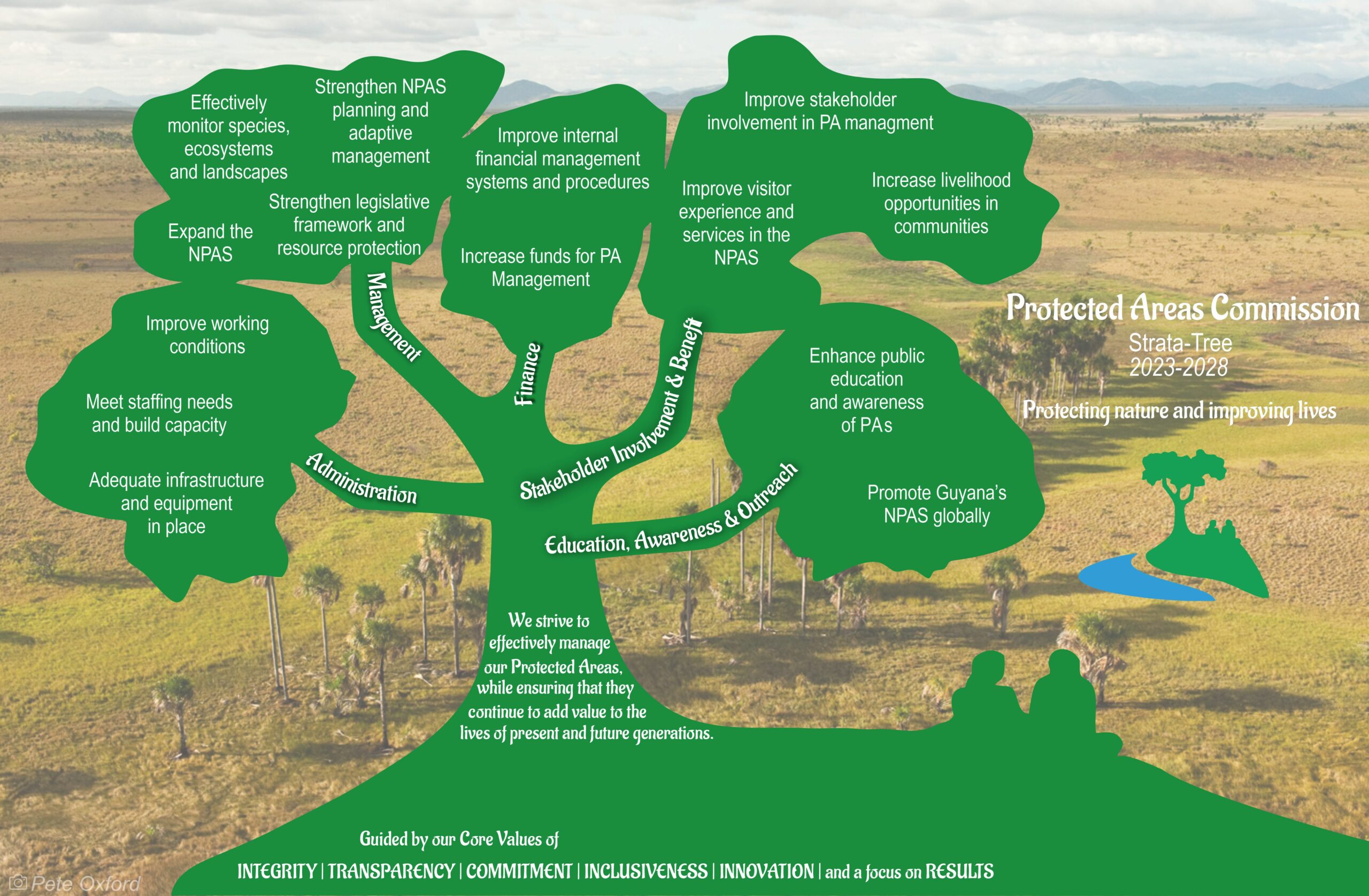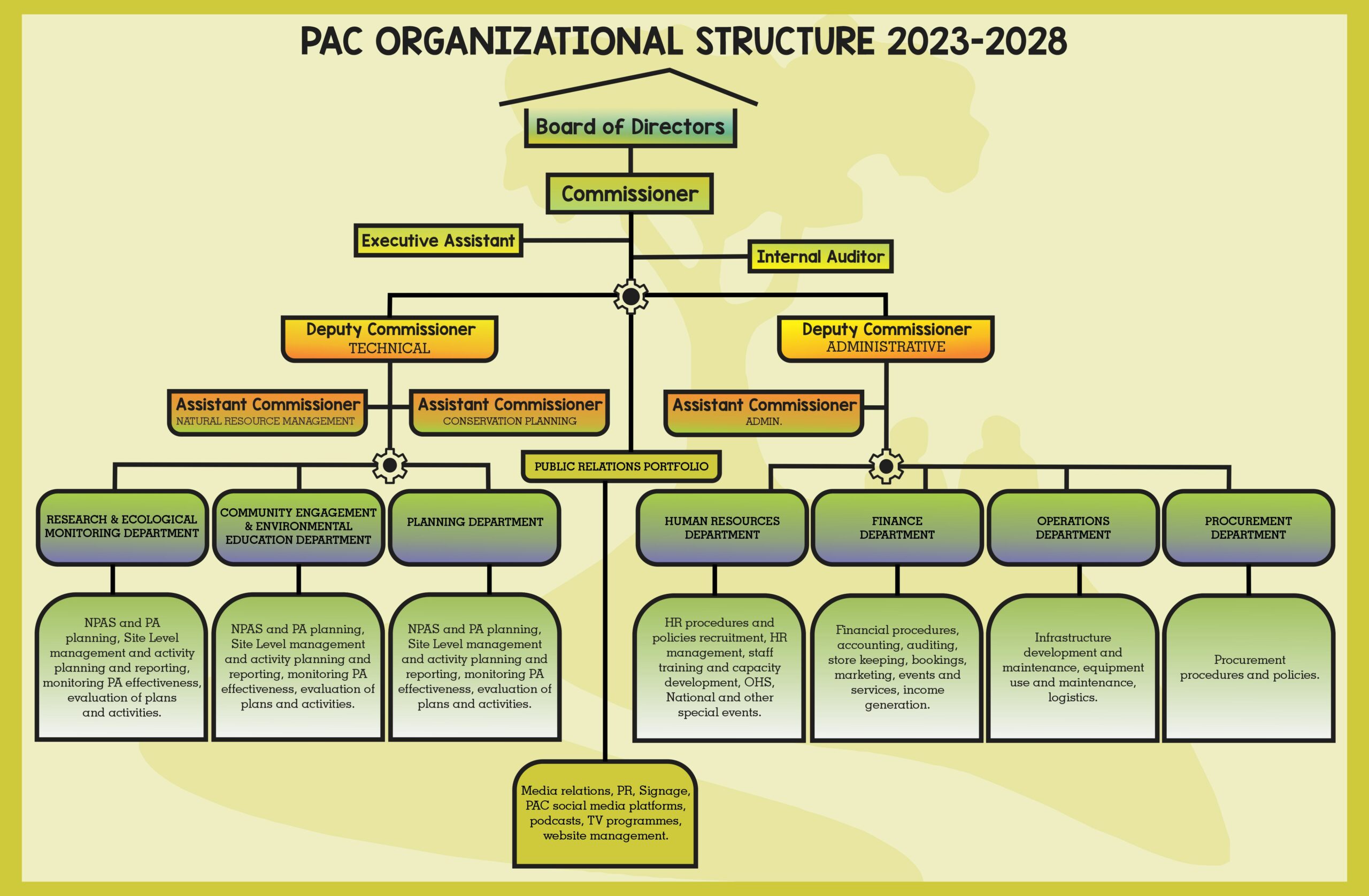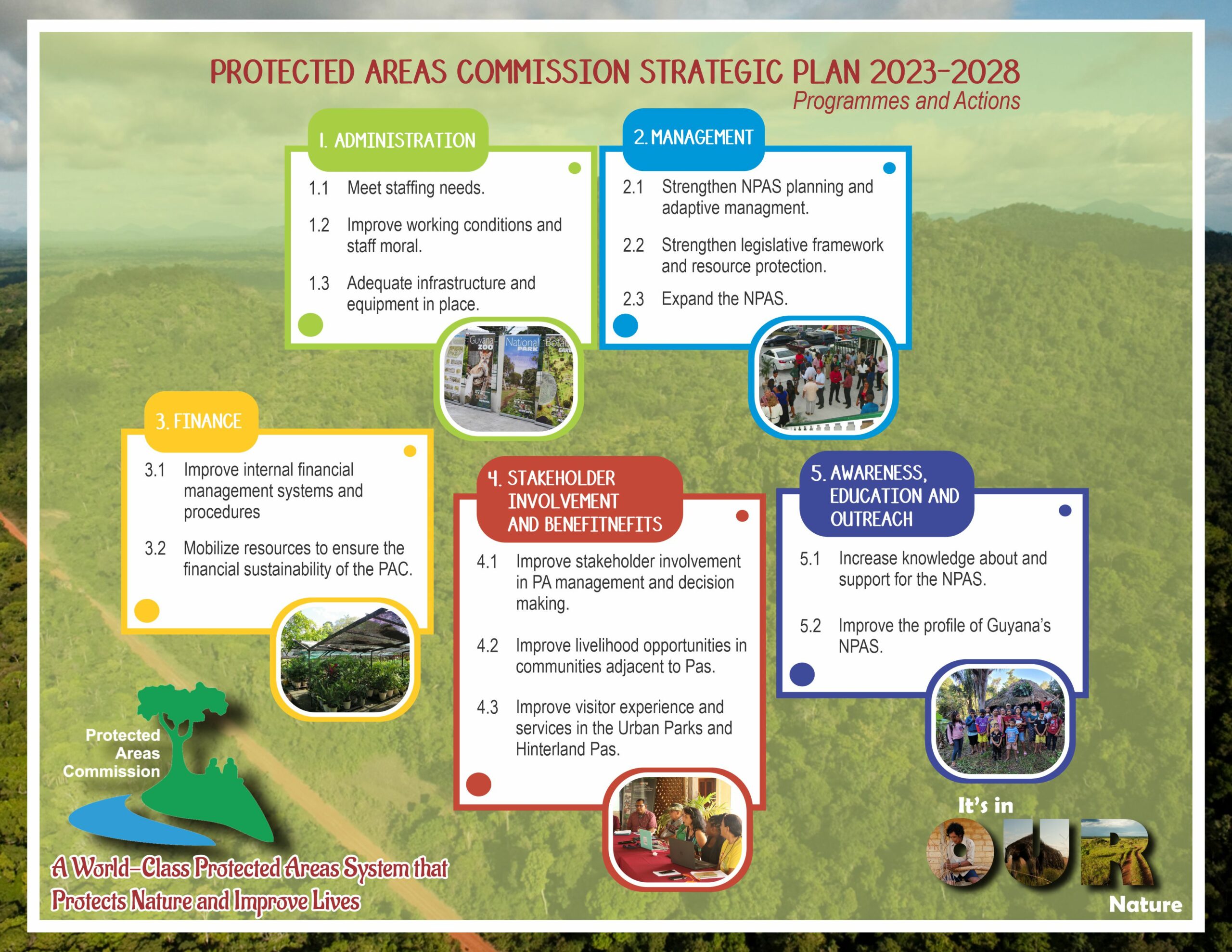Our Work
Importance of Our Work
Biodiversity
Guyana is part of the Guiana Shield, a distinct eco- region of the larger Amazon Basin. The Guiana shield alone has over 3000 vertebrate species made up of 1,168 fresh water fish, 269 amphibians (54% endemics), 295 reptiles (29% endemics), 1,004 birds (7.7% endemics) and 282 mammals (11% endemics). This biological richness is all the more significant considering that the Amazon houses approximately 10% of the world’s known biodiversity and is the world’s largest remaining tract of tropical rainforest.
Guyana is centrally positioned within the Guiana shield, containing much of its representative ecosystems and biodiversity, while still featuring many endangered Amazonian species. Approximately 80% of all mammal and bird species, 61% of reptile species and 50% of amphibian species occurring in the Guiana Shield are found in Guyana. Of these, 260 species are on the CITES list and approximately 6% of its mammals and fish, 3-4% of its amphibians and reptiles, and 1% of its bird species are globally threatened. Our work therefore is important to help process this valuable biodiversity through the effective management of Guyana’s NPAS.
Animals and plants are also important to the livelihood and development of indigenous communities adjacent to protected areas. In Guyana these communities have traditionally used PAs and their resources sustainably, and have deep cultural and spiritual connections to these areas. The PAC is committed to supporting sustainable resource use by communities.
National Development
Guyana’s ecosystems and biodiversity are generally well preserved compared to other countries. However, its natural resources are under increasing pressure from extractive industries, the wild meat trade and overfishing of inland rivers. While these activities are economically important, the country’s resources must be used sustainably in order to achieve long term prosperity.
The NPAS therefore plays a critical role in ensuring Guyana’s natural heritage and its social- ecological service values remain for future generations. Protected Areas in essence are Guyana’s Green Banks, conserving natural resources and populations of globally important species, helping climate change mitigation and adaptation, and providing benefits and alternative livelihoods for present and future generations.
Guyana is signatory to the:
Convention on International Trade in Endangered Species of Wild Fauna and Flora (CITES) (1977).
United Nations Framework Convention on Climate Change (1992).
United Nations Convention on Biological Diversity (UNCBD) (1994).
United Nations Convention to combat Desertification (1994)
Nagoya Protocol on Access to Genetic Resources and Benefit Sharing (2014)
More importantly, and at the national level, protected areas and conservation is playing a pivotal role in Guyana’s sustainable development agenda through the implementation of the Low Carbon Development Strategy 2030.
Climate Change Mitigation and Adaptation
Climate change negatively affects biodiversity, livelihoods and natural processes at a global level. Its impacts are particularly evident in developing countries such as Guyana, where populations are often heavily dependent on natural resources. More than a fifth of all carbon emissions come from global deforestation. With 80% of its land covered in primary forest, Guyana boasts one of the lowest deforestation rates in South America, thus making it a global carbon sink, and a key player in any international effort to mitigate climate change. In particular, Guyana’s protected forests and their biodiversity play a significant role in climate change adaptation as natural buffers and regulators of floods, droughts and even rising sea levels. They also provide important ecosystem services and options for sustainable
Ecosystem and Biodiversity Representation
The current protected areas system represents two of Guyana’s four defined (NBSAP, 2012) ecosystems – forest, wetland & coastal; the inclusion of representative areas of Guyana’s marine and savannah ecosystems remain a priority for the system.
Although Guyana’s ecosystems have not been studied as intensively as in other South American countries, new species to science and/ or newly recorded for Guyana are regularly found when studies are conducted. For example, several new amphibian and reptile species were recorded in the mid 2000’s in the KNP and, more recently (2012) a new tarantula species.
At a minimum, the NPAS is estimated to contain 70% of Guyana’s mammals, 60% of its birds and 43% of its plant species. All six species of cats and all eight species of primates that occur in Guyana can be found in the NPAS. The Kanuku Mountains Protected Area (KMPA) alone is thought to have the second highest diversity of bats of any PA in the world, while the Shell Beach Protected Area (SBPA) is proposed as a globally important birding area (IBA) supporting more than 200 coastal and migratory bird species. It is thought that healthy populations of at least 30% of the globally threatened mammals found in Guyana and approximately 90% of threatened reptiles occur in our national protected areas.
Stakeholder Communities
Many of the areas adjacent to protected areas are titled Amerindian lands comprising six out of nine of Guyana’s indigenous groups (45 communities). There is a long history and culture of resource use by communities in the country’s protected areas, including hunting, fishing, farming and gathering. Many of these areas are therefore extremely important features in the livelihoods and long term developmental aspirations of local communities. The management of the NPAS is therefore defined by a “Parks for People” approach with community participation and enhanced local benefits being fundamental to the work of the PAC.
Tourism and Recreation
Guyana’s tourism and travel industry contributes approximately US$220 million (8.9%) to its GDP (direct and indirect expenditure), however this sectors’ contribution to GDP has the potential to grow significantly. The development of Guyana’s protected areas system will directly contribute to the growth of the country’s tourism sector, through the protection of important landmarks, landscapes and biodiversity, tourism marketing, and the development of tourism-compatible infrastructure. A strengthened partnership with key stakeholders is therefore a priority to help grow and develop Guyana’s eco-tourism services and products. At the centre of this tourism/protected area partnership is Kaieteur National Park, which is Guyana’s primary tourist site and received more than 7000 visitors in 2014 a 250% increase when compared to 2000.
Visitation within urban parks is also significant and growing. The National Park, for instance, is visited approximately by more than 1500 persons daily, while the Zoological Park has between 6-8000 visitors per month. This makes the urban parks extremely valuable platform not just for marketing tourism to a domestic market, but also for improving awareness, education and support among Guyanese for the conservation of Guyana’s biodiversity.
Our Strategy
In order to effectively manage the National Protected areas system, a strategic plan was developed and implemented during 2016 – 2022. A second strategic plan for the period 2023 – 2028 has been developed based on a careful evaluation of the previous plan to ensure we align with our Vision and Mandate. It focuses on preserving our core values, while developing sound operating practices and a flexible approach to our every-changing environment.
Vision
A world class National Protected Areas System in Guyana that protects nature and improve lives
Mission:
To effectively manage Guyana’s National Protected Areas and their features while ensuring they continue to add value to the lives of present and future generations.
Core Values
- Transparency: We promote an open organisation that is accountable to its stakeholders
- Commitment: We guarantee to undertake activities demonstrating passion, pride and dedication at all times.
- Inclusiveness: We value and respect diversity and contributions from all stakeholders, and will treat each person in a professional manner that reflects our values
- Innovation: We seek to develop novel ideas using international best practices to respond to changing environments and stakeholder needs
- Integrity: We act morally, ethically, and with honesty at all times
- Results: We work proactively to produce prompt and effective results
The Plan covers both the hinterland protected areas and urban parks. The strategy covers five key programme areas ((i) Administration, (ii) Management, (iii) Finance, (iv) Stakeholder Involvement and Benefits and (v) Awareness, Education and Outreach) with its own set of strategic objectives. These objectives guide our annual planning and ensure that all activities conducted are working towards achieving our vision.

Organizational Structure
The organisational structure represents the PAC’s growth in the long-term. Recruitment of personnel within the structure will be gradual and based on need and on resources available to the organisation. The structure is designed to ensure roles and responsibilities, including line management, are clearly defined within Departments. This will allow for easier mentoring and monitoring of staff performance and work plans. It is envisioned that all Departments will be involved across all sites. This structure strives to provide opportunities for staff to build their capacity and move up within the structure, thus promoting institutional capacity building and staff retention.

Our Programme of Work
Our Strategic Framework is used as the basis for developing our annual work plan. It also informs the content and direction of the Site Level Management Plans. Site Level Management plans were developed for the Hinterland Protected Areas. We are currently working on designing management plans for our urban sites. The image below outlines the 5 key programme areas and their specific objectives. It is our hope that by 2028 the management of Guyana’s National Protected Areas System would be significantly improved and expanded in keeping with our national and international obligations as articulated in the Low Carbon Development Strategy 2030 and the Kunming-Montreal Global Biodiversity Framework. Ultimately, we intend to continually work towards our vision of “A World class Protected Areas System that protects nature and improve lives”

Location: National Park, Thomas Lands, Georgetown, Guyana.
Phone: + 592 227 2265 + 592 226 2323
Email: info@pac.gov.gy
Monday – Thursday 8 am – 4:30 pm
Friday 8 am – 3:30 pm
Saturday – Sunday – Closed
Protected Areas
- Office of the President
- Protected Areas Trust (Guyana)
- Environmental Protection Agency
- Guyana Wildlife Conservation and Management Commission
- Guyana Geology and Mines Commission
- Guyana Lands and Survey Commission
- Ministry of Natural Resources
- Ministry of Amerindian Affairs
- Ministry of Tourism, Industry and Commerce
- Guyana Tourism Authority
- Iwokrama International Centre
- Low Carbon Development Strategy
Newsletter
[mc4wp_form id=”240″]
